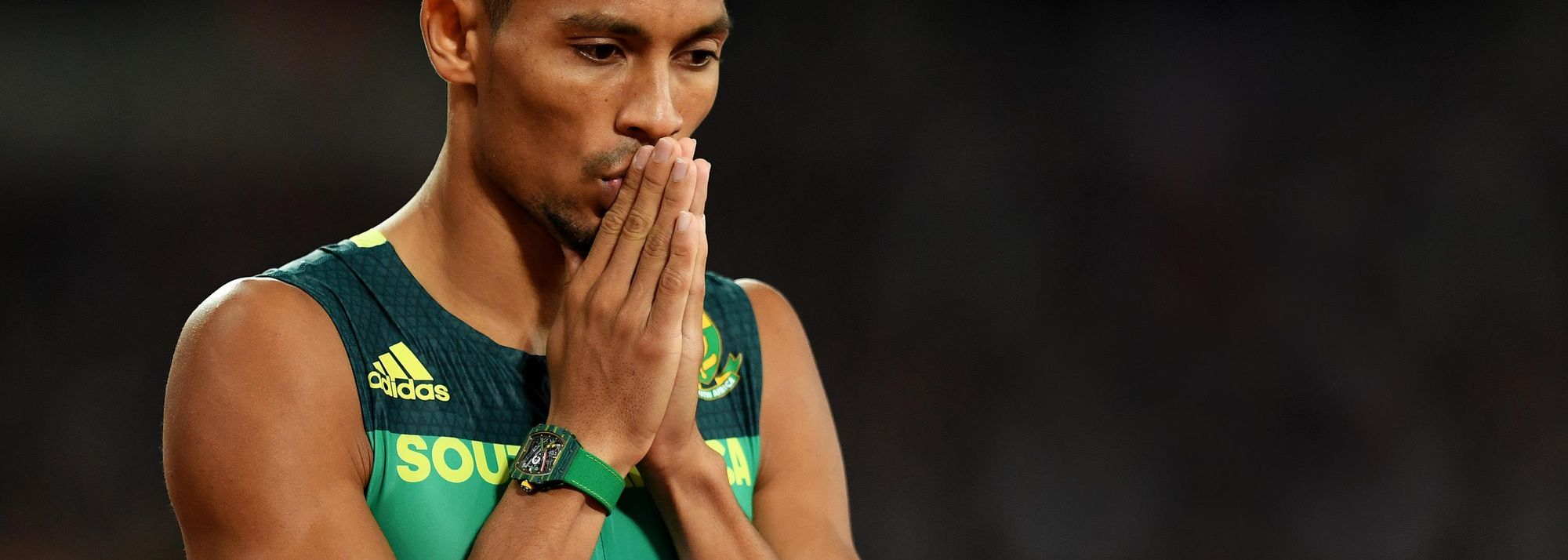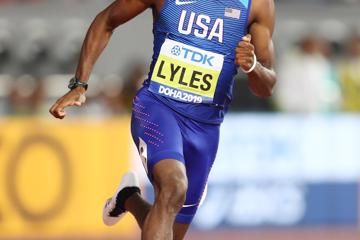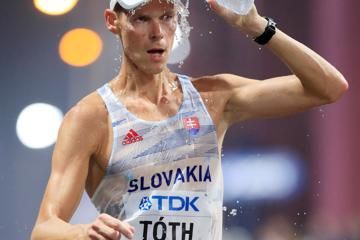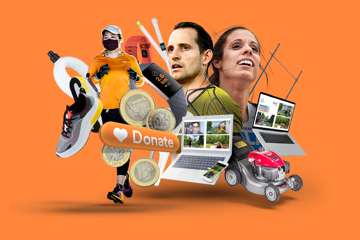Wayde van Niekerk at the World Championships London 2017 (© AFP / Getty Images)
Wayde van Niekerk was nervous. For an athlete of his calibre, an unofficial 100m race on grass in mid-February should have been a formality. A routine rust-buster. A glorified training session.
Yet for the 27-year-old South African, it felt like so much more.
When the gun fired that evening in Bloemfontein, he ripped up the home straight and took victory in a hand-timed 10.20. It meant nothing, yet it meant everything.
For the past two years, this simple act of sprinting had been filled with so much doubt. But here, at last, was some certainty, proof that his body could once again be taken to full throttle.
“There were definitely a bit of nerves, questions,” he admits. “But I decided to put all those aside and see what my body wants to do.”
Later that week, Van Niekerk rocked up to another local meeting in Bloemfontein and, on a synthetic track, clocked 20.31 for 200m and 10.10 for 100m in the space of an hour.
“It showed me I still have that speed and I definitely still have the strength that I had before the injury,” he says. “That gave me a massive boost.”
Which brings us to the injury. That injury. The one that divides his career down the middle: before and after October 2017.
At the time he was the reigning Olympic and world champion, but his decision to take part in a charity touch rugby match soon brought his career to a standstill. Van Niekerk sustained medial and lateral tears in his meniscus and tore his anterior cruciate ligament (ACL).
Amid the punishing physical pain that followed and the long, lonely hours of rehab, perhaps the hardest thing to deal with was the guilt. Van Niekerk carried it like a loaded barbell.
“I can’t blame anyone else for my injury,” he says. “I’m the one who made the decision to play a rugby game, the one who put myself in that position. I’m a professional athlete and the decision I take is on me but what that (brought was) a bit of guilt and wishing I did not do what I did. But it was my reality, it happened and putting blame on it wasn’t going to get me to come back stronger.”
Post-injury, ‘seeking peace within this chaos’
Even in the good times, Van Niekerk was one for self-scrutiny, a trait that re-emerged during the months that followed.
“Doubt is part of the process,” he says. “There were doubts even before I was injured. I’m a very critical person of myself and I’m very hard on myself so that creates some doubt and questions.”
Severe injury can thrust athletes through the various stages of grief, lamenting the loss of their health, longing for its return. They can experience denial, anger, depression, but it didn’t take long for Van Niekerk to reach the final stage: acceptance.
“Knowing myself and spending time with my mentors, it made it easier to snap out of the dark places when the negatives were creeping up on me,” he says. “It helped me seek a positive or a peace within this chaos.
“Mentally I’ve been practising to get myself more confident so when things aren’t going my way, I stand firm in who I am and what I believe in. That’s what’s driven me forward. Knowing my quality and what I can achieve has made it so much easier to work harder than ever before to come back.”
View this post on Instagram
The line of progress was not linear. It rarely is. Still, the overall trend went in the right direction, even if Van Niekerk occasionally had to go in reverse.
“With an injury like an ACL, there are so many setbacks where you need to take a step back and make sure you’re making responsible decisions that won’t hurt you or cause any more harm. I had to be very cautious to find the line between pushing my boundaries and not overdoing it. We slowly but surely started getting the hang of it.”
New pains popped up so often that it sometimes felt like he was playing whack-a-mole to keep them at bay. Last June Van Niekerk was primed for a return to racing when he developed up a bone bruise in his knee, which ultimately ruled him out of the World Championships in Doha.
“We would have random hamstring pains, calf pains, but my biggest one was the bone bruise,” he says. “Those setbacks threw me off and they really affected me massively.”
The thing is, it was always this way. At his level, athletes operate on the fine line between supreme fitness and physical failure. It was like that when he was smashing records, and it’s like that today.
“As a sportsperson you’ve always got niggles and pains and aches everywhere,” he says. “I have some of my aches and pains of previously and it’s part of the game, something you can’t avoid.”
The key is keeping them in check as he builds fitness, brick by brick, back to where he wants it to be.
“I feel I have the strength and speed to produce world-class times and challenge my record,” he says. “That’s where my mind is set.”
World record: ‘It motivates me to work harder’
If he ever needs reminding of how it looks when all the pieces fall into place, Van Niekerk gets it every time he appears at an official engagement. The video is always played. The Rio 2016 Olympic Games, that astonishing final when he set off like a bat out of hell from lane eight and simply never came back.
Looking on in the stands, his coach ‘Tannie’ Ans Botha summoned an image as she watched her star protégé bring all their work to fruition, smashing the world record with 43.03.
“I got the picture of a lot of different coloured ribbons tied together on top, and every ribbon represented an aspect of athletics – muscle endurance, speed endurance, speed, strength – and in that race all those ribbons came together,” she said. “When he went over that line, the final knot was tied.”
For Van Niekerk, every reflection on that race allows the weight of his achievement to sink in a little more.
“It becomes more and more of a reality,” he says. “I get to appreciate it and cherish the blessing that I had. It motivates me to work harder and compete at that level for many more years to come. I’m at a stage where I’m extremely hungry so I’m going to do it: try to push my body to those limits.”
He remains the only man in history to run under 10 seconds for 100m (9.94), 20 seconds for 200m (19.84), 31 seconds for 300m (30.81) and 44 seconds for 400m (43.03), but it’s that latter mark that remains the apple of his eye.
Is 42-point the next target?
“It’s got to be,” he says. “I’m someone that’s stuck on going sub-43 and with that I want to improve my 100m and 200m times. I believe I’ve got the abilities to be competitive internationally in all three events.”
For now, lockdown and long distance relationship with coach
Like most of the world, life for Van Niekerk has not been normal for quite some time. South Africa imposed one of the world’s strictest lockdowns in late March, which kept him confined to training at home for more than a month.
“Luckily I have a gym set up at home,” he says. “I’ve got quite a technically advanced treadmill so it challenges me in ways that become quite difficult.”
A couple of weeks ago citizens were allowed to exercise outdoors from 7-9am so Van Niekerk did workouts on the roads by his house. The tracks remain closed.
“Things are good, we’re okay,” he says. “Every day the cases are increasing in the entire country; that’s a bit scary but where I’m staying (Bloemfontein) is okay.”
View this post on Instagram
For several weeks he’s been unable to work directly with Botha, his 78-year-old coach, though on the way home from a trip to the grocery store last week Van Niekerk stopped by her house.
“I stood outside at her fence and found out how she’s been,” he says. “Things are a bit difficult for her but it’s the safest decision for her to stay home. Tannie is very driven, very motivated to get up every day, so this is a time where I need to step up and make sure she’s fine. She doesn’t have that opportunity to work with us the way she’d love to so us athletes need to take responsibility.”
While he was on course to reach the top again in 2020, Van Niekerk can see the silver lining in the postponement of the Olympics. “There’s time to work on specific areas that need your attention. You can find positives wherever you look for them, you just need to sit back and see where you need to work.”
Readying to challenge the 'new breed'
The journey to getting fast will be taken slow, but Van Niekerk is still relishing a return to racing once it’s safe to do so.
“Obviously we need to wait patiently, but when the opportunity comes we need to take it. We need those races to get fit, but you have to choose wisely because you don’t want to hurt yourself and sit out for another three years.”
The injury, says Van Niekerk, has forced him to “step up the game even more intense than before”.
During his absence, he watched from afar as a new breed emerged over 400m, athletes like Steven Gardiner, Michael Norman and Fred Kerley.
Van Niekerk thinks back to his own breakthrough in 2015, when he first broke 44 seconds at the Paris Diamond League and went on to win the world title in 43.48 – the same time Gardiner ran to win in Doha last year.
“I have massive respect for (them),” he says of his rivals. “I came through that process and I know the hunger and determination that’s needed to break through those levels to do great things. It’s a stage where anything is possible so obviously I don’t take (their challenge) lightly.”
But just like that race in Rio, Van Niekerk will have eyes only for his lane.
“I need to focus on me and where I want to be as an athlete and what I want to achieve: that’s to continue to be number one and improve myself, strengthen myself,” he says. “Whoever pops up during this process, I’ll accept the challenge. May the best man win.”
Cathal Dennehy for World Athletics









